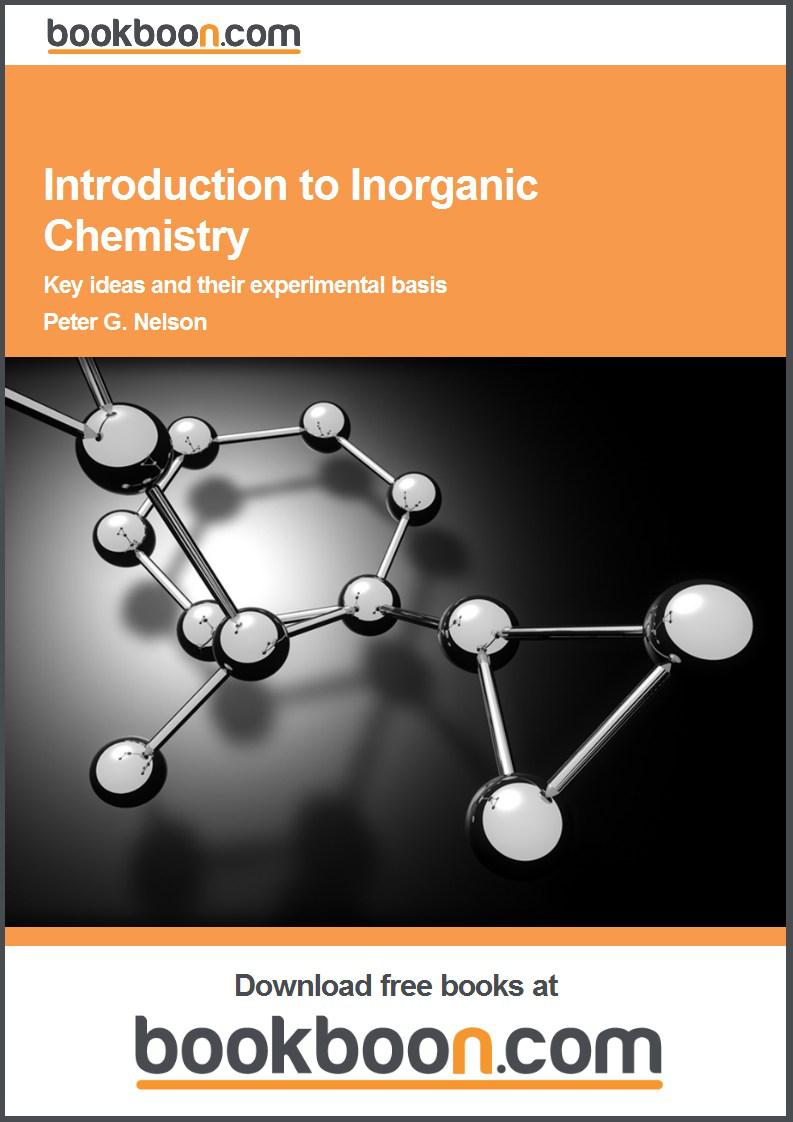
introduction-to-inorganic-chemistry
.pdf

Peter G. Nelson
Introduction to Inorganic Chemistry
Key ideas and their experimental basis
Download free ebooks at bookboon.com
2

Introduction to Inorganic Chemistry: Key ideas and their experimental basis © 2011 Peter G. Nelson & Ventus Publishing ApS
ISBN 978-87-7681-732-9
Download free ebooks at bookboon.com
3

Introduction to Inorganic Chemistry Contents
Contents
1 |
Introduction |
10 |
|
Chemistry |
10 |
|
Inorganic Chemistry |
10 |
|
This course |
10 |
|
Broader context |
11 |
|
Further reading |
11 |
2 |
The relative importance of different elements |
12 |
2.1 |
The relative abundance of different elements |
12 |
2.2 |
The relative consumption of different elements |
14 |
2.3 |
Elements sought after from very low-grade ores |
14 |
|
Further reading |
15 |
3 |
Classification of elements into metals and nonmetals |
16 |
3.1 |
Types of element |
16 |
3.2 |
Assignment of elements to classes |
19 |
3.3 |
Volatilities of metals and nonmetals |
20 |
3.4 |
Chemical properties of metals and nonmetals |
20 |
4 |
Binary compounds |
22 |
4.1 |
General classification of compounds |
22 |
4.2 |
Limiting types of binary compound |
22 |
Please click the advert
Download free ebooks at bookboon.com
4

Introduction to Inorganic Chemistry |
Contents |
|
|
|
|
4.3 |
Metallic compounds |
22 |
4.4 |
Nonmetallic compounds |
25 |
4.5 |
Salt-like compounds |
26 |
4.6 |
Intermediate types of binary compound |
29 |
|
Further reading |
30 |
5 |
On the nature of the limiting types of binary compound |
31 |
5.1 |
Nonmetallic compounds |
31 |
5.2 |
Salt-like compounds |
38 |
5.3 |
Metallic compounds |
40 |
5.4 |
Limiting types of chemical bond |
43 |
|
Further reading |
46 |
6 |
Types of formula |
47 |
6.1 |
Empirical formulae |
47 |
6.2 |
Molecular formulae |
47 |
6.3 |
Structural formulae |
47 |
6.4 |
Geometrical formulae |
50 |
7 |
Classification of elements according to the electrochemical series |
51 |
7.1 |
Electrical and chemical series |
51 |
7.2 |
The electrochemical series |
55 |
7.3 |
Electronegativity |
57 |
7.4 |
Polar numbers |
59 |
Please click the advert
Download free ebooks at bookboon.com
5

Introduction to Inorganic Chemistry |
|
Contents |
||||
|
|
|
|
|
|
|
7.5 |
Nomenclature of binary compounds |
61 |
||||
|
|
Further reading |
63 |
|||
8 |
|
Valency |
64 |
|||
8.1 |
Ordinary valency |
64 |
||||
8.2 |
Electrovalency |
66 |
||||
8.3 |
Covalency |
68 |
||||
8.4 |
Applicability of the three kinds of valency (V, E, and C) |
68 |
||||
8.5 |
Extension |
71 |
||||
|
|
Table: Principal valencies of some important elements |
73 |
|||
9 |
|
Pseudo-binary compounds |
75 |
|||
9.1 |
Introduction |
75 |
||||
9.2 |
On the nature of pseudo-binary compounds |
77 |
||||
9.3 |
Some important radicals |
78 |
||||
9.4 |
Nomenclature |
79 |
||||
10 |
The Periodic Table |
81 |
||||
10.1 |
The Periodic Law |
81 |
||||
10.2 |
Nomenclature |
84 |
||||
10.3 |
Use of the table |
87 |
||||
10.4 |
General features |
87 |
||||
10.5 |
A better form of table |
89 |
||||
|
|
Further reading |
90 |
|||
|
|
|
|
|
|
|
|
|
|
|
|
|
|
|
|
|
|
|
|
|
|
|
|
|
|
|
|
Please click the advert
Download free ebooks at bookboon.com
6

Introduction to Inorganic Chemistry |
Contents |
|
|
|
|
11 |
Interpretation of main-group valencies in terms of a simple model of |
|
|
main-group atoms |
91 |
11.1 |
Basic theory |
91 |
11.2 |
Refinement of model in the light of the quantum theory of atoms |
93 |
11.3 |
The dative bond |
95 |
11.4 |
Isoelectronic principle |
98 |
11.5 |
Transition elements |
100 |
11.6 |
Shapes of molecules |
100 |
|
Further reading |
101 |
12 |
Compounds of higher order than two |
102 |
12.1 |
Limiting types |
102 |
12.2 |
Metallic compounds |
102 |
12.3 |
Nonmetallic and salt-like compounds |
102 |
13 |
Coordination compounds |
106 |
13.1 |
Basic theory |
106 |
13.2 |
Terminology of coordination compounds |
110 |
13.3 |
Nomenclature of coordination compounds |
112 |
13.4 |
Bonding in coordination compounds |
113 |
13.5 |
Nonclassical coordination compounds |
118 |
|
Further reading |
119 |
Please click the advert
Download free ebooks at bookboon.com
7

Introduction to Inorganic Chemistry |
Contents |
|
|
|
|
14 |
Loose compounds and solutions |
120 |
14.1 |
Solutions |
120 |
14.2 |
Loose compounds |
122 |
15 |
Types of chemical reaction |
126 |
15.1 |
General types |
126 |
15.2 |
Some special types of reaction |
129 |
16 |
Acids, bases, and salts |
132 |
16.1 |
Classical conception |
132 |
16.2 |
Stoicheiometric conception |
136 |
16.3 |
Electrolytic conception |
137 |
16.4 |
Equations for acid-base reactions |
139 |
16.5 |
Further aspects |
141 |
16.6 |
Lowry-Brønsted conception of acids and bases |
143 |
16.7 |
Solvent-system conception of acids and bases |
146 |
16.8 |
Other conceptions of acids and bases |
147 |
17 |
Oxidation and reduction |
148 |
17.1 |
Basic theory |
148 |
17.2 |
Half equations |
150 |
17.3 |
On the balancing of equations for redox reactions |
153 |
18 |
Further study |
157 |
Please click the advert
Download free ebooks at bookboon.com
8

Introduction to Inorganic Chemistry |
Contents |
|
|
Appendix 1 Hints and answers |
158 |
A1.1 Answers to questions and exercises, Chapters 1 - 5 |
158 |
A1.2 Hints for exercises, Section 5.2 |
161 |
A1.3 Answers to questions and exercises, Chapters 6 - 9 |
162 |
A1.4 Answers to questions and exercises, Chapters 10 - 12 |
166 |
A1.5 Answers to questions and exercises, Chapters 13 - 18 |
168 |
Appendix 2 Pictures of structures |
171 |
Appendix 3 |
174 |
Appendix 4 |
175 |
Appendix 5 |
177 |
Download free ebooks at bookboon.com
9

Introduction to Inorganic Chemistry |
Introduction |
|
|
1 Introduction
Chemistry
Chemistry comprises two related but distinct activities:
(i)the quest for an understanding of matter and material change,
(ii)the utilization of material change for human ends.
Ideally, the first activity provides the necessary know-how for the pursuit of the second, but in practice, the help it can give is only partial, and the second activity has to fall back on trial and error techniques in order to achieve its ends. This means that a good chemist is one who not only has a mastery of chemical theory, but also a good knowledge of chemical facts. With such a knowledge, he can direct a trial and error approach to practical problems in the most promising directions.
Inorganic Chemistry
Organic chemistry is usually defined as the chemistry of compounds of carbon, inorganic chemistry being then the chemistry of all the other elements. This distinction is not a completely satisfactory one, however, since there are many compounds of carbon that are quite different from those studied by organic chemists
(e.g. tungsten carbide, used for tipping cutting tools) and there are many compounds of other elements that are very similar to those studied under organic chemistry (e.g. the silicon analogues of the hydrocarbons). It is best, therefore, to think of inorganic chemistry as the chemistry of all the elements, with organic chemistry as being a more detailed study of certain important aspects of one of them - viz. the hydrocarbons and their derivatives.
Thinking of inorganic chemistry in this way brings together aspects of the chemistry of an element that would otherwise tend to become separated. For example, alcohols and ethers are usually dealt with under organic chemistry and are not thought of as being part of the chemistry of oxygen. Once they are, however, they can be set alongside the other compounds of oxygen, and a relationship immediately becomes apparent that might otherwise be lost, viz. that expressed by the formulae:
H–O–H R–O–H R–O–R′
This course
My aim in this course is to derive the key ideas of inorganic chemistry from chemical observations. I do this by following the reasoning of chemists who have developed these ideas.
Many instructors take a different approach. They start with the quantum theory of atoms and molecules, and deduce the key ideas from this. The quantum theory enables the energy of an atom or molecule to be calculated, and the average motion of the electrons in it. With the help of modern computers, it gives remarkably accurate results.
Download free ebooks at bookboon.com
10
